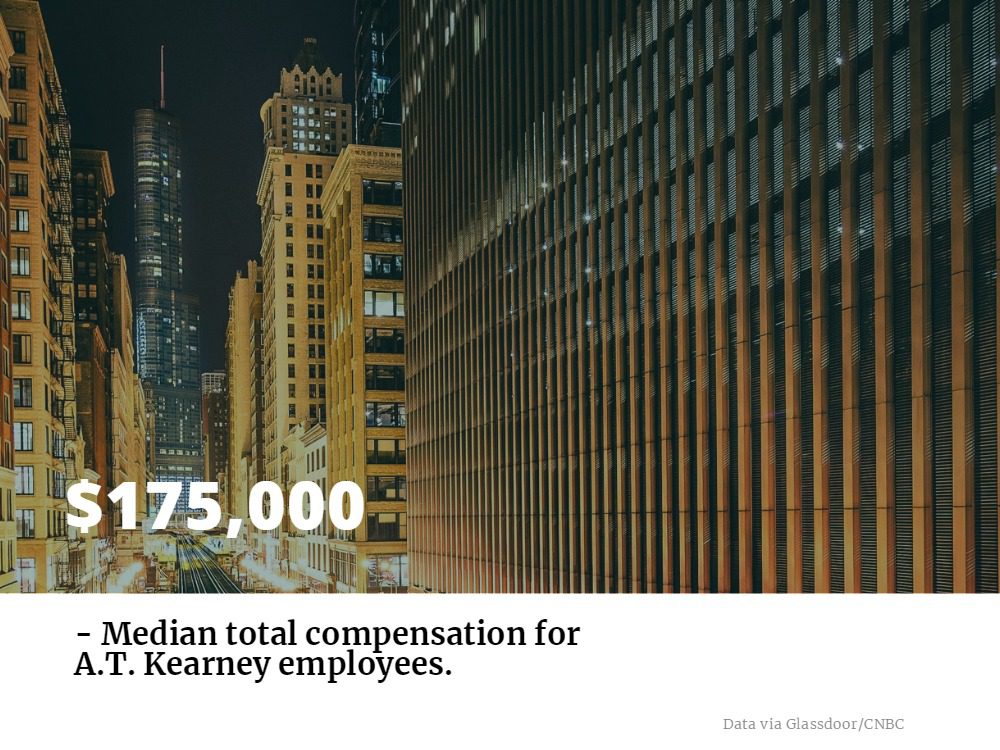Your Future A.T. Kearney Career is Waiting for You

For many organizations, finding a candidate with an MBA degree on their resume is a shortcut to knowing how well they will succeed at the company. With the strong foundational business skills the degree provides, companies can feel safe hiring an MBA student or graduate.
Founded in the mid 1920s, A.T. Kearney is a Chicago-based global management consulting firm and on of the more active MBA recruiters. As of 2016, the company holds 60 offices in over 40 countries throughout the globe, with roughly 3,500 employees.
Why Work at A.T. Kearney?
A.T. Kearney has made a commitment to creating transformational experiences for its clients, it makes the same promise for its employees. The company strongly believes that diversity is a key part of its culture, and aims to create an inclusive environment where people of any background can find success. The firm is unique in its offering of personalized programs that can help each employee find the perfect path to career success. Programs like Success with Flex, which offers flexible scheduling options, Pathway for Parents, which provides resources for working caregivers, or the Encore program, which helps professionals reenter the workforce after a long break, demonstrate the company’s commitment to creating a positive work environment for all its employees.
On Glassdoor, anonymous current and former A.T. Kearney employees largely praise the consulting company, giving it an overall positive rating of 4.2. In context, that’s just outside of the “2018 Best Places to Work” top 100 ranking, making it one of the more attractive destinations for current and future MBA grads. Employees cite flexible scheduling and good health insurance policies among the myriad of benefits, but at the end of the day, the pay is what stands out.
According to Glassdoor data, compiled by CNBC, A.T. Kearney employees earn the highest median salary of any employer in the entire United States, with a median total base compensation of $175,000. And with some positively alluring bonuses, that puts employees in the $200,000 range.

How To Get Your Foot in the Door
A.T. Kearney recruits talent in a number of ways. The company already works alongside a number of top business schools in the country, offering networking events, career fairs, and presentations on campus. Students can also begin the interviewing process right on campus. Even if the company does not offer programs at a particular campus, students can still apply directly through the website.
Another important way interested MBAs can get their foot in the door is through the Summer Consultant Program; a ten-week internship which teaches students about what its like to be a consultant at A.T. Kearney. The program starts with a three-day training program at a central location, helping interns to understand the company’s culture and specific approaches to consulting. After the three-day program, interns will return to their local offices and begin working on project assignments. At A.T. Kearney, Summer Consultants are treated the same as any other full-time associate and must collaborate with managers, principles and partners to create client solutions.
“The Summer Consultant Program allowed me to make an impact through my client work, get a real feel for the office’s culture, and, most importantly, build strong relationships with future colleagues at all levels of the firm. In all, the experience left me excited about the opportunity to join the firm full-time,” says Kate Maheu, a full-time associate who started as a Summer Consultant in 2013.
What Types of Jobs are Available?
From summer consultants and beyond, A.T. Kearney has a number of jobs for which they are seeking talented MBA graduates. Below are just a couple examples of positions open at the time of writing.
Associate – Digital Transformation:
The first of its kind among management firms, the Digital Transformation practice at A.T. Kearney offers organizations help in making sense of their changing needs in an constantly evolving business world. The Digital Transformation Associate works alongside clients, collaborating and problem-solving in a fast paced environment with the potential to make a big impact. The perfect consultant for this role would possess an MBA from a leading institution and have 5-10 years of success in Business and Technology.
The Contracts Officer at A.T. Kearney will be a senior member of the Public Sector team at the company, responsible for management of contracts between the firm and Government agencies. The ideal candidate for this position would hold have active business connections in government sectors and more than ten years experience in a consulting environment. An undergraduate degree is required for this role with an MBA highly preferred.
How the House Tax Cuts and Jobs Act Could Affect Grad Students

Days before the House of Representatives voted to pass the House Tax Cuts and Jobs Act on the morning of Thursday, November 16, budget experts at the Wharton School at the University of Pennsylvania broke down the proposed bill, discussing its broad potential impact.
The breakdown, per the Wharton Budget Model, focused on three principle findings:
- “This brief reports Penn Wharton Budget Model’s (PWBM) dynamic analysis of The House Tax Cuts and Jobs Act (TCJA), as amended and reported out by the Ways and Means Committee on November 9, 2017.”
- “After including the tax bill’s effects on economic growth, TCJA is projected to reduce revenues between $1.5 trillion and $1.7 trillion. Debt rises by about $2.0 trillion over the same period. Looking beyond the 10-year budget window, by 2040, revenue falls between $3.6 trillion and $4.4 trillion while debt increases by $6.4 to $6.9 trillion.”
- “In 2027, GDP is between 0.4 percent and 0.9 percent higher than with no tax changes. By 2040, the difference between GDP under the House tax bill and current policy is between 0.0 percent and 0.8 percent, due to larger debt.”
The research focused on broader implications, rather than zeroing in on how the bill potentially effects different socioeconomic classes. In conclusion, the research “projects that The House Tax Cuts and Jobs Act reduces federal tax revenue in both the short and long-run relative to current policy. In the near term, there is a small boost to GDP, but that increase diminishes over time.”
Brian Naylor at NPR notes that the bill was passed mostly on bipartisan terms, with Republicans in the U.S. House of Representatives largely pushing it through to the Senate without much push-back. “The vote was almost along party lines, with no Democrats voting in support of the bill and some GOP defections over provisions in the measure that would eliminate important tax deductions taken by constituents in some high tax states,” he writes.
The bill is less likely to pass in the Senate as it did in the House, according to reports from the New York Times. If it were to, however, the new legislation would directly affect graduate students across the board—including MBA students.
Section 117(d) of the bill, which can read here, indicates that all graduate students that receive any kind of tuition waiver will still have to pay taxes on the removed costs. For MBA students at schools like the Tepper School of Business at Carnegie Mellon University, this could mean a year-end cost increase of at least 25 percent, if not more. For students in Ph.D. programs, which often give tuition waivers to help bring in valuable research, the costs can be significantly higher, according to CNBC.
“This makes graduate school unattainable for anybody not already very well off,” 24-year-old grad student Kelly Balmes told NPR. “It also creates a diversity problem, which graduate STEM programs already have.”
MBA Alum Spotlight: Wharton Alum and Alphabet CFO Ruth Porat

In March 2015, the New York Times called Ruth Porat one of the most powerful women on Wall Street, and claimed she was poised to “immediately become one of the most powerful women in Silicon Valley” as CFO of Google’s corporate umbrella, Alphabet.
Do Women Entrepreneurs Get Less VC Funding? Wharton and Columbia Researchers Find a Large Gender Gap

Over the last few years, there has been a lot of talk about more women in business. From the promotion of organizations like the Forté Foundation—which seeks to enhance women in business—to CNBC claiming “the Golden Age for women entrepreneurs has finally begun,” enterprising women seem to be everywhere. Unfortunately, this doesn’t mean that the deck is stacked in their favor. In fact, researchers from Columbia Business School and The Wharton School found the opposite was true.
The Gender Gap in Startup Funding
In a paper published in the Academy of Management Journal titled, “We Ask Men to Win & Women Not to Lose: Closing the Gender Gap in Startup Funding,” researchers looked at how women fared compared to men when they were trying to get funding for their startups.
After reviewing footage from the TechCrunch Disrupt startup competition, the researchers found that women were asked entirely different types of questions about their companies compared to their male counterparts. Men received more questions about their project’s potential for growth, while women received questions on the opposite end, about their potential risks and losses. This difference in questioning had a measurable impact on the funding each startup received.
The research paper, written by Dana Kanze (a Columbia Business School Ph.D. student), Laura Huang (a Wharton School Professor), Mark A. Conley (a Columbia Psychology Ph.D.), and E. Tory Higgins (a Columbia Psychology Professor), sought to delve into the enormous gender gap revealed in venture capital funding. According to the paper, only 2 percent of VC funding goes to women entrepreneurs in spite of the fact that women own 38 percent of U.S. businesses and represent 7 percent of venture capital firms.
One of the keys to this drastic difference in funding was how VCs—both male and female—framed funding questions for women-created businesses. Kanze explained the thought process in a Forbes article.
“According to the psychological theory of regulatory focus, investors adopted what’s called a promotion orientation when quizzing male entrepreneurs, which means they focused on hopes, achievements, advancement, and ideals,” Kanze said. “Conversely, when questioning female entrepreneurs, they embraced a prevention orientation, which is concerned with safety, responsibility, security, and vigilance.”
Inside the Research
To study how this difference in questioning impacted women and men entrepreneurs, the research team reviewed the Q&A sessions of 189 startup entrepreneurs—12 percent of whom were women—held by 140 prominent venture capitalists—40 percent of whom were women. Using software to analyze each session, researchers discovered that 67 percent of questions posted to men were promotion-oriented while 66 percent of questions posted to women were prevention-oriented.
In the end, the study found that this difference in questioning led to a huge difference in VC funding. Among comparable companies, the research team found that businesses that were asked prevention-oriented questions raised (on average) $2.3 million in funds in 2017, while their promotion-focused counterparts raised $16.8 million—nearly seven times more.
“In fact, for every additional prevention question asked of an entrepreneur, the startup raised a staggering $3.8 million less, on average,” Kanze told Forbes. She continued, saying, “Controlling for factors that may influence funding outcomes—like measures of startups’ capital needs, quality, and age, as well as entrepreneurs’ past experience—we discovered that the prevalence of prevention questions completely explained the relationship between entrepreneur gender and startup funding.”
However, there was some good news. For female entrepreneurs who received prevention-focused questions but responded with promotion-type answers, they were able to raise $7.9 million, versus $563,000. This suggests that regardless of how VCs phrase their questions, entrepreneurs can recover much of their funding potential if they answer in the positive.
To test their findings, the research team conducted an experiment that recreated the TechCrunch Disrupt conditions with 194 VCs—30 percent of whom were women—and 106 entrepreneurs—47 percent of whom were women. After removing startup specific details, the team asked the VCs to allocate $400,000 to their chosen entrepreneur.
According to the Kanze in a Harvard Business Review article, the team found that: “Angel investors allocated an average of $81,113 to startups in the prevention question, promotion answer condition—1.6 times larger than the $52,369 average allocated to those in the prevention question, prevention answer condition. Similarly, ordinary investors gave an average of $96,321 to the prevention question, promotion answer condition—1.7 times larger than the $55,377 average given to the prevention question, prevention answer condition.”
Speaking with Professor Laura Huang
To gain additional insight into the results of the research paper, we spoke with Professor Laura Huang at the Wharton School. Here’s what she has to say.
- What was the most surprising result that came out of your study?
“It was surprising that both men and women investors were equally as likely to ask prevention-focused questions to women, as opposed to promotion-focused. It wasn’t that men were the only ones biased, but that both genders were equally as likely to be biased.”
- Do you have any advice for female entrepreneurs looking to raise venture capital?
“Stop it in its tracks. When you see something like this happening, stop it immediately and redirect the response so that you’re making yourself on equal footing. Don’t allow that train of thought to go through where you’re getting asked prevention-focused questions and investors are focused on the risk. Answer the question that’s asked but redirect your response toward possibilities and success.”
- How do you think VC funding can change for the future to close the gender gap?
“Part of it is an awareness on the investors’ side. It’s also up to the entrepreneurs to redirect each question toward the right focus. A lot of this gap is implicit. Investors don’t realize they’re asking prevention-focused questions of women; they just automatically ask certain questions to each gender. Awareness around the tendency toward prevention-focused questions for women entrepreneurs and a focus on redirection toward promotion is key.”
Metro News & Notes: Stanford Wants You in the Midwest, MBA Essays and More

Good morning and happy Friday!
Here are a few stories you may have missed from the week that was …
Stanford Will Pay MBAs $160,000 to Work in the U.S. Midwest | CNBC
Earlier this week, the Stanford Graduates School of Business announced three winners of its first-ever Stanford USA MBA Fellowship, which will reportedly pay each student upwards of $160,000 for two years of tuition. CNBC writer Catherine Clifford explains:
“To be eligible for the scholarship, you have to have a connection to the Midwest. You can be a current resident of a Midwestern state, which Stanford defines as Illinois, Indiana, Iowa, Kansas, Michigan, Minnesota, Missouri, Nebraska, North Dakota, Ohio, South Dakota or Wisconsin. Alternatively, you could have lived for three consecutive years in one of those states, have graduated high school in one of those states or have ‘experiences that demonstrate a strong commitment to, and interest in, the development of the region.'”
There is a stipulation with the lucrative scholarship, however. Those students must agree to work in the Midwest within two years of graduation. Clifford notes that by the times grads have been out of Stanford GSB for four years, at least two of those years will have to have been working in the Midwest.
“The winners of the first Stanford USA MBA Fellowship are Adam Verhasselt, Amanda Donohue-Hansen and Taylor Seabaugh,” Clifford writes. “Verhasselt was raised on a dairy farm owned by his family in Wisconsin and is the first in his family to graduate from college. Donohue-Hansen is from California but graduated from University of Minnesota and lived and work there for 10 years. Seabaugh grew up in St. Louis, Missouri, and returned after graduating from college to work at 3M and volunteer at local public schools.”
Read more about the Stanford USA MBA Fellowship here.
High School Students Dream Big – with Help of MBA Mentors | The Globe & Mail
Three Toronto metro high school students recently earned some valuable hands-on help from second-year Schulich School of Business MBA candidate Cortney Mills. The partnership came to fruition from the semester-long case competition Summit Leaders, founded last year by MBA students from the Rotman School of Management at the University of Toronto, writes the Globe & Mail. The goal of the nonprofit summit is to help underprivileged high schoolers from the community, giving them in-person lessons about business and entrepreneurship.
“’A lot of students don’t realize this [business] is an avenue they can take and they are often the brightest people,’ says David St. Bernard, a Co-Founder of Summit Leaders who graduated this spring with combined degrees in business and law at U of T.”
“’Sometimes they need that little push,’ he says of the younger students in the program. ‘Our idea is to give them the avenue to open up their ideas and create more connections within the community.’ Students do not have to choose a business career, he adds, ‘but at least we give them the opportunity to choose.’”
Find out more about the Summit Leaders nonprofit program here.
Your MBA Application Essay Mastered | Financial Times
Admissions teams know that essays are where students have to individually shine. Work experience, grades and GMAT score tell a lot about a student, of course, but the essay is a chance for them to stick out beyond traditional parameters.
In a recent piece with the Financial Times, Yuan Ding, Dean of the China Europe International Business School, says, “[The essay] is where we learn about applicants’ career aspiration, understanding of China, and writing skills.”
Rob Weiler, UCLA Anderson School of Management MBA Program Associate Dean, also notes how students need to be pretty concise with their words. “If an applicant attempts to add too much supplemental information, chances are they are trying too hard,” he says in the piece. Applicants to the UCLA Anderson MBA program all have a 500-world limit on their essays.
In contrast, institutions like the IESE Business School in Spain do not limit applicants to any standards on essays, offering immensely flexible entry capabilities. Dean Franz Heukamp says, “The ones that grab our attention do so not because they say something we have never heard before, are wild or outrageous. What makes a cover letter special is when it is very clear that the candidate knows what he or she wants to achieve professionally.”
Read more about what school’s may or may not expect from your application essay here.
Washington Business Ranked Best in U.S. for 2017

For 11 years, CNBC has ranked the nation’s states to determine which are the most economically competitive. After months of data analysis—reviewing more than 60 measures of competitiveness from taxes to regulatory climate and quality of the workforce—Washington came out as “America’s Top State for Business in 2017.” Continue reading…
